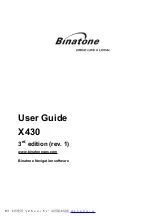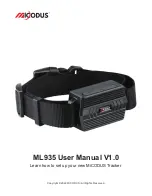
4.6. USING
CIRCULAR REGIONS
(GEO-FENCES, CHECK
POINTS)
This event is going to be reported to DA 7 which has to be defined
before the event occurs so the
Event Machine
can generate the report
to a valid group of DPs.
The region has to be defined too. To do so, use the
GR
message.
This is the only signal-defining message that requires more than a
single command to configure the signal. This because as specified on
the TAIP reference, the
GR
message defines not a whole region but
a region’s single point. One example for the definition of region 26
using three points is:
>
SGR26001-025795009999
<
>
SGR26011-025840550099
<
>
SGR2602U-025849440001
<
4.6
Using
Circular Regions
(geo-fences, check points)
Circular regions are defined with a latitude/longitude center an a ra-
dius in meters. Circular Regions can be used to enclose an special
delivery zone or to set a checkpoint on a route. These regions are
defined with the
XAGR
message and the associated circular region sig-
nals’ are the
Kxx
signals. For example, to define a Circular Region
centered at N27,68694 E86,72917 having a radius of 500m, send to
the unit:
S0867291000500000000
Now, to make
e-track
TM
beep and send a report whenever it enters
this region:
>SED20NV0;K15+;ACT=SXAZZ2<
For more information see the
XAGR
message.
4.7
Using
Regions
(geo-fences)
e-track
TM
detects when its geo-position is inside or outside of up to
30 user-defined polygons (50 points maximum each). These polygon-
defined regions are defined with the
GR
message and the associated
regions’ signals are the
Rxx
signals.
Detailed instructions on polygon-regions’ definition is given in the
GR
TAIP message section of the TAIP reference found in this docu-
ment.
77
















































